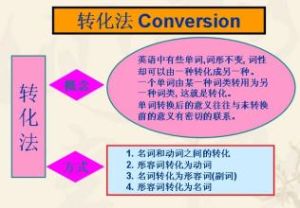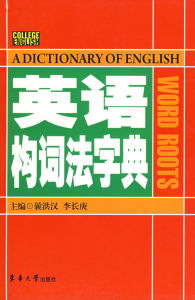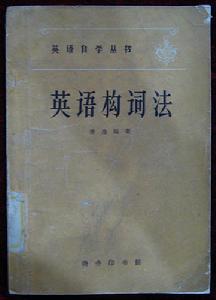基本概述
英語中的詞分兩大類:開放性詞類(open class),主要包括名詞、動詞、形容詞和副詞,因為這些詞類總有新詞增加。介詞、代詞、冠詞、指示詞、連詞等被稱為封閉性詞類(closed class)。
轉化法
轉化法就是一個詞項不用加後綴就成為或轉化為新詞類的派生方法(Quirk et al 1985)。以動詞 attack 為例 (例如The enemy attacked us at night),它和名詞attack(例如The enemy launched an attack on us at night)的詞形相同;名詞attack就被看作是由動詞attack轉化生成的。在描述詞與詞之間的轉化時,由於沒附加後綴用來作為依據,決定哪個詞項應被看作是詞根或是派生形式有一定的困難。通常我們把抽象名詞和施動者名詞看作是派生名詞(例如:desire, answer, walk 等)。用轉化法產生的詞主要是名詞、形容詞和動詞。
名詞轉化成動詞
 構詞法
構詞法a. V表示“把…放在N所指的位置”。例如:
--The corridor was carpeted. (在…鋪了地毯)
--This factory cans fish to be sent abroad. (把…裝罐)
--The newspapers headlined his long record of accomplishments. (把…當作頭條新聞報導)
--After the tiger was caught, it was caged. (把…關在籠子裡)
--A team of experts at Columbia is now cataloguing the tapes and indexing the transcripts,
which will be available for scholarly research.哥倫比亞的一批專家正在整理錄音資料彙編成目,同時又將其書面材料編成索引,以供學者研 究。
這種用法常見的詞還有bottle,corner,floor,garage,position,shelve等。
b. V表示“給予N”
--They sheltered (為…提供住宿)the orphans.
--The sweets are then coated (塗在…上)with chocolate.
--Her eyes were masked (遮蓋)by huge sunglasses.
這種用法常見的詞還有butter, commission,grease,muzzle,oil,plaster等。
c. V表示“把N去掉”
--Bill weeded the garden. (除草)
--Would you peel me an apple please? (削皮)
--He fell and skinned his knee. 他摔了一跤,擦破了膝蓋的皮。
這種用法常見的詞還有core, dust, gut, top-and-tail, 等。
d. V表示“把N所指的對象用作一種與之有具體聯繫的任何活動的工具”。例如:
--I had to elbow my way through the crowd to have a close look at the goods. (用肘擠)
--She fingered the soft silk.(用手感觸)
--He braked the car in vain; the brakes would not hold. (剎車)
這種用法常見的詞還有hand, fiddle, glue, knife 等。
e. V表示“充當名詞的角色”。這裡的名詞可以是指人、動物或無生命的物體。例如:
--She mothered the orphan. (母親般照管…)
--Tom parroted what the boss had said. (鸚鵡學舌…)
--The incident shadowed their meeting. 那次事件給他們的會見蒙上了陰影。
這種用法常見的詞還有chaperon, father, nurse, pilot, referee等。
f. V表示“使…變成N”或“使…成為N”
--Please cash this check for me. (把…兌現)
--A government study targets earnings from tourism at $140 million by 1980. (target意為“把… 定為目標”)
--Occupations are grouped into separate categories. (將…形成組)
這種用法常見的詞還有knight, cripple等。
g. V表示“用N送/去”
--Will you please mail the parcel? (郵寄)
--My bike is under repair, so I had to bus to the city this morning instead of cycling. (坐車;踩腳踏車)
--Let me motor you to town. (用車運送)
這種用法常見的詞還有ship, telegraph, boat, canoe 等。
形容詞轉化成動詞
 構詞法
構詞法--The vast amounts of energy now expended in warming our surface surroundings when they are too cold, and cooling them when they are too warm, could be saved. (使…溫暖;使… 涼爽)
--Nothing dries sooner than a tear. (變乾)
--This is considered an important way of narrowing the gap between the rich and the poor countries. (使…縮小)
--The sea gradually calmed down as we steamed out. (平靜下來)
--Slow down before you reach the crossroads. (減速)
--We put him on the bed to sober up. (清醒起來)
動詞轉化成名詞
在現代英語中,由動詞形成的名詞相對地說數量不大,而且使用範圍也不廣。從語義角度將這類詞分為以下幾種(Quirk et al 1985)。
a. 轉化生成的N可表示V對應的“狀態”(一般為“思想狀態” 或“感覺狀態”)、“事件/活動”、或“V-ing
的方式”
--He had a desire to be a scientist. (渴望)
--Uncle Jeremy is a man of few wants and is happy with simple pleasures. (需求)
--Her love for him never wavered. (愛)
--The fall from his horse broke his leg. (跌落)
--His act would always get a huge laugh. (笑)
--His release was secured by the perseverance of his wife. (釋放)
--Refinery owners have already resorted to temporary shutdowns. (停工)
--I can always recognize her by her walk. (走路的樣子)
表示“狀態”常見的詞還有dismay, doubt, smell, taste等;表示“事件/活動”常見的詞還有attempt, hit, laugh, search, swim, walk-out, blow-out (of a tyre);表示“V-ing的方式”常見的詞還有throw和 lie。
b. 轉化生成的N可表示V的賓語、主語、工具、地點等。
--I made a great find in an old bookshop yesterday. (發現,指買到難得的書)
--Several good takes were ruined by the surge of children into our working area. (take指的是被拍攝的鏡頭)
--We said that we wouldn’t be relying on handouts from anyone for our future.(施捨物)
--Stop being a bore. (惹人厭煩的人或物)
--He looks like a tramp. (流浪漢)
--That boy is a sneak — he told the teacher what I had done. (告密生)
--The cloth is a good cover for the table. (罩子)
--There is no cure for the common cold. (特效藥物)
--Use brown polish on these shoes. (擦亮劑)
--The road is full of sharp turns. (轉彎)
--The event became the divide between two eras of Chinese history. (分界線)
--In this mountain retreat I would find the best climate in the country. (休養所)
表示V的賓語常見的詞還有answer, bet, catch等。表示V的主語常見的詞還有a cheat(騙子), a sneak(鬼鬼祟祟的人), a coach(教練員), a good kick(足球踢得很好的人), a crack shot(神槍手)等。表示V的工具常見的詞還有paper, wrap, wrench等。表示V的地點常見的詞還有rise, lay-by, drive-in等。
值得注意的是,有些動詞加上詞綴可派生為名詞,例如repeatàrepetition, removeàremoval等,這時它們和由轉化法生成的名詞形成一對同源、同類的詞,這對詞在意義或文體色彩上會存在 著一定的差異,但在意義上也會發生交叉現象,在使用中要注意區分。例如:repeat多指重演、 重播、重奏或重唱的部分,在口語中可作“重複”解;而repetition常作“重複”解。remove和 removal均可作“移動”“搬家”講,但removal還有“解職”“排除”“切除”的意義,remove可作“學校中的升級”“程度”“階段”講。command 為“指揮”“指令”;commandment為“戒律”“聖訓”。Combine 為“聯合企業”“聯合收割機”;combination為“聯合”“結合體”。Exhaust為“排除的氣”“排氣裝置”; exhaustion為“筋疲力盡”。divide多指“分水嶺”“分界線”;division則指“分開”“分歧”“分派”,但divide 也可作“分歧”解,division也可作“分界線”解。從上面的敘述中我們可以看出轉化法所具有的活躍的構詞能力。正因為如此,轉化法是一種異常重要的構詞方式。
派生法
在詞根前面加前綴或在詞根後面加後綴構成一個與原單詞意義相近或截然相反的新詞叫作派生法。
前綴
除少數前綴外,前綴一般改變單詞的意義,不改變詞性;後綴一般改變詞類,而不引起詞義的變化。
1.表示否定意義的前綴常用的有dis-,il-,im-,in-,ir-,mis-,non-,un-等,在單詞的前面加這類前綴常構成與該詞意義相反的新詞。例如:
appear出現→disappear消失
correct正確的→incorrect不正確的
lead帶領→mislead領錯
stop停下→non-stop不停
possible可能的→impossible不可能的
2.表示其他意義的前綴常用的有a-(多構成表語形容詞),anti- (反對;抵抗),auto- (自動),co- (共同),en- (使),inter- (互相),re- (再;又),sub- (下面的;次;小),tele- (強調距離)等。例如:
alone單獨的anti-gas防毒氣的
auto-chart自動圖表
cooperate合作enjoy使高興
internet網際網路reuse再用
subway捷運telephone電話
3.改變詞性的前綴有:en-,de-,be-,a-,out等。
(1)en-
該前綴通常加在形容詞或名詞前構成動詞,例如:
large(形容詞,大的)→enlarge(動詞,擴大)
courage(名詞,勇氣)→encourage(動詞,鼓勵)
(2)de-
該前綴通常加在名詞之前構成動詞,其意義大多和原名詞相反。例如:
value(名詞,價值)→devalue(動詞,降低…的價值)
(3)be-
該前綴可加在名詞或形容詞前構成動詞。例如:
friend(名詞,朋友)→befriend(動詞,與…交朋友)
little(形容詞,小的)→belittle(動詞,輕視)
(4)a-
這個是構詞力較強的前綴。常加在名詞或描述性動詞之前,構成形容詞或副詞。例如:
board(名詞,甲板)→aboard(副詞,在船上)
side(名詞,旁邊)→aside(副詞,在旁邊)
sleep(動詞,睡覺)→asleep(形容詞,睡著的)
(5)out-
①可加在名詞之前構成形容詞。例如:
door(名詞,門)→outdoor(形容詞,戶外的)
②可加在動詞之前構成名詞。例如:
break(動詞,打破)→outbreak(名詞,爆發)
注意:英語中的前綴in-,un-通常表示“不”或“…的相反”的含義,因此由其構成的派生詞一般具有否定的意義。然而,有些由這兩個前綴構成的派生詞並非有否定的意義,而與詞根同義或近義。著名學者周海中教授在《in-,un-不一定表示“否定”》一文中就舉了若干個例子,如:coming/incoming(來到),habit/inhabit(居住於),loose/unloose(解開,釋放),rip/unrip(撕開)等。這類派生詞雖然不多,但值得注意,勿望詞生義。
後綴
英語單詞不僅可以通過加前綴構成新詞,也可加後綴構成新詞。後綴通常會改變單詞的詞性,構成意義相近的其他詞性;少數後綴還會改變詞義,變為與原來詞義相反的新詞。
(1)構成名詞的後綴常用的有-ence,-(e)r/ -or (從事某事的人),-ese (某地人),-ess (雌性),-ian (精通……的人),-ist (專業人員),-ment (性質;狀態),-ness (性質;狀態),-tion(動作;過程)等。例如:
differ不同於→difference區別
write寫→writer作家
Japan日本→Japanese日本人
act表演→actress女演員
music音樂→musician音樂家
(2)構成動詞的後綴常用的有-(e)n (多用於形容詞之後),-fy (使……化),-ize (使……成為)。例如:
wide→widen加寬
beauty→beautify美化
pure→purify提純
real→realize意識到
organ→organize組織
(3)構成形容詞的後綴常用的有-al,
-able (有能力的),-(a)n(某國人的),-en (多用於表示材料的名詞後),-ern (方向的),-ese(某國人的),-ful,-(ic)al,-ish,-ive,-less (表示否定),-like (像……的),-ly,-ous,-some,-y (表示天氣)等。例如:
nature自然→natural自然的
reason道理→reasonable有道理的
America美國→American美國的
China中國→Chinese中國人的
gold金子→golden金的
east東→eastern東方的
child孩子→childish孩子氣的
snow雪→snowy雪的
(4)構成副詞的常用後綴有-ly (主要用於形容詞之後表示方式或程度),-ward(s) (主要用於表示方位的詞之後表示方向)。例如:
angry生氣的→angrily生氣地
to到→towards朝……,向……
east東方→eastward向東
(5)構成數詞的後綴有-teen (十幾),-ty (幾十),-th (構成序數詞)。例如:
six六→sixteen十六→sixteenth第十六
four四→forty四十→fortieth第四十
合成法
合成名詞
構成方式例詞
名詞+名詞weekend周末
名詞+動詞daybreak黎明
名詞+動名詞handwriting書法
名詞+及物動詞+er/or pain-killer止痛藥
名詞+介詞+名詞editor-in-chief總編輯
代詞+名詞she-wolf母狼
動詞+名詞typewriter打字機
動名詞+名詞reading-room閱覽室
現在分詞+名詞flying-fish飛魚
形容詞+名詞gentleman紳士
副詞+動詞outbreak爆發
介詞+名詞afternoon下午
合成形容詞
名詞+形容詞snow-white雪白的
名詞+現在分詞English-speaking講英語的
名詞+to+名詞face-to-face面對面的
名詞+過去分詞man-made人造的
數詞+名詞one-way單行的
數詞+名詞+形容詞two-year-old兩歲的
數詞+名詞+ed five-storeyed五層的
動詞+副詞see-through透明的
形容詞+名詞high-class高級的
形容詞+名詞+ed noble-minded高尚的
形容詞+形容詞light-blue淺藍色的
形容詞+現在分詞good-looking相貌好看的
副詞+形容詞ever-green常青的
副詞+現在分詞hard-working勤勞的
副詞+過去分詞well-known著名的
副詞+名詞fast-food專門提供快餐服務的
介詞+名詞downhill下坡的
合成動詞
名詞+動詞sleep-walk夢遊
形容詞+動詞white-wash粉刷
副詞+動詞overthrow推翻
合成副詞
形容詞+名詞hotfoot匆忙地
形容詞+副詞everywhere到處
副詞+副詞however儘管如此
介詞+名詞beforehand事先
介詞+副詞forever永遠
合成代詞
代詞賓格+self herself她自己
物主代詞+self myself我自己
形容詞+名詞anything任何東西
合成介詞
副詞+名詞inside在……裡面
介詞+副詞within在……之內
副詞+介詞into進入
截短法
截短法,即將單詞縮寫,詞義和詞性保持不變,主要有截頭、去尾、截頭去尾等形式。
截頭
telephone→phone
airplane→plane
omnibus→bus
去尾
mathematics→maths
cooperate→coop
examination→exam
kilogram→kilo
laboratory→lab
taxicab→taxi
截頭去尾
influenza→flu
refrigerator→fridge
prescription→script
縮略法
在英語中,我們區分三種構詞力十分強的縮略方法:首字母拼音法(acronym)、截成法(clipping)和混成法(blending)。非正式是它們共同的色彩。
首字母拼音法(acronym)
首字母縮略詞是由構成一個名稱的單詞的開首字母合成的。這種構詞的方法主要用於組織的名稱 (例如:EEC = European Economic Community歐洲經濟共同體),機械裝置或武器(例如: SLV = satellite launch vehicle發射人造衛星的運載火箭),專業用語(例如:ESP = English for Special Purposes特殊用途英語),一類人、職稱或頭銜(例如:CEO = chief executive officer總經理),替代上文已提到的完整詞或詞組。首字母縮略詞有以下兩種發音方式:
a. 按各個開首字母發音。例如:
--C.O.D. cash on delivery (貨到即付)
--DIY do-it-yourself (自己動手)
--IOC International Olympic Committee (國際奧委會)
--IMF International Monetary Fund (國際貨幣基金組織)
--FBI Federal Bureau of Investigation (聯邦調查局)
--MIT Massachusetts Institute of Technology (麻省理工大學)
b. 按拼音方法讀音,把首字母縮略詞看做一個單詞。例如:
--SALT Strategic Arms Limitation Talks (限制戰略武器會談)
--NATO North Atlantic Treaty Organization (北大西洋公約組織)
--Laser lightwave amplification by stimulated emission of radiation (雷射)
--UNESCO the United Nations Educational Scientific and Cultural Organization (聯合國教科文組織)
--WASP White Anglo-Saxon Protestant (盎格魯-薩克遜裔的清教徒白人)
其他方法
混合法
(混成法)
混合法,即將兩個詞混合或各取一部分緊縮而成一個新詞。後半部分表示主體;前半部分表示屬性。
news broadcast→newscast新聞廣播
television broadcast→telecast電視播送
smoke and fog→smog煙霧
helicopter airport→heliport直升飛機場
首尾縮略
首尾字母縮略法,即用單詞首尾字母組成一個新詞。讀音主要有兩種形式,即各字母分別讀音;作為一個單詞讀音。
very important person→VIP (讀字母音)要人;大人物
television→TV (讀字母音)電視
Testing of English as a Foreign Language→TOEFL托福
Nato
截成法(clipping) 特別是在非正式用法中,我們有時會把某些多音節詞縮成一個音節,從而產生截成詞。截成法一般可分為以下三種(後兩種方法都不大常見):
a. 截去詞的尾部:ad = advertisement(廣告),demo = demonstration(演示), expo = exposition(展覽會),pro = professional(專業人員),gents = gentleman’s lavatory (男廁),pub = public house(酒店),stereophonic(立體聲)
b. 截去詞的首部:phone = telephone(電話),plane = airplane(飛機),chute = parachute (降落傘),copter = helicopter(直升機)
c. 截去詞的首部和尾部:flu = influenza(流感),tec = detective(偵探),fridge = refrigerator (冰櫃)
綴合法
(affixation)
英語詞綴分為前綴和後綴兩種。一般來說,前綴只是改變詞的意義,但不改變其詞類。後綴不僅改變詞的意義,而且使單詞由一種詞類轉變為另一種詞類。
前綴法
(prefixation)
a. 表示否定的前綴
in-,im-,il-,ir-表示“not”“the converse of”。例如:inefficient (無效率的),infrequent(不頻繁的),improper(不合適的),impossible(不可能的),illiterate(無文化的),irregular(不規則的)
non-表示“not”“the lack of”“the opposite of”。例如:nonaggression(不侵犯),nonconductor (絕緣體),nonsense(廢話),nonsmoker(不抽菸的人),nonfiction(非小說的散文文學),nonviolent(非暴力的),nonproductive(非生產的),nonexistent(不存在的),nonstop (直達的)un-表示“not”“the converse of”。例如:unpleasant(不愉快的),unemployed (無工作的),unconcerned(漠不關心的),unsuccessfully(不成功的),unhappily (不開心的),undo(復原),unsay(撤回),unload(從…卸下)
b. 表示倒序或否定的前綴
de-表示“reversing the action”。例如:decentralize(使分散),defrost(除霜),desegregate (取消種族隔離),de-escalate(降低)
dis-表示“reversing the action”“not”。例如:disappear(消失),discount(折價),disagreement (不一致),disadvantage(不利),disobey(不服從),disorder(雜亂),djsloyal(不義的)
c. 表示輕蔑的前綴
mal-表示“badly”“bad”。例如:maltreat(虐待),malformed(畸形的),malfunction(故障),malnutrition(營養失調)
mis-表示“wrongly”“astray”。例如:mislead(誤導),misbehavior(品行不端),mispronounce (發音錯誤),misunderstanding(誤解),misdeed(錯誤行徑),misprint(誤印)
pseudo-表示“false”“imitation”。例如:pseudoclassicism (偽古典主義),pseudograph (偽造檔案),pseudomorph (偽形),pseudonym(假名)
d. 表示程度或尺度的前綴
co-表示“joint(ly)”“on equal footing”。例如:co-education(男女合校制的教育),coheir (共同繼承人),copilot(副駕駛員),cohabit(同居),cooperate(合作)
mini-表示“little”。例如:minibus(小型巴士),minicab(小型汽車),mini-bar(迷你酒吧)
over-表示“too (much)”。例如:overanxious(過度焦慮的),overpopulation(人口過剩),overcrowd(容納過多的人),overwork(操勞過度),overcharge(索價過高)
sub-表示“under”“lower than”“further”。例如:subconscious(潛意識),subcommittee (小組委員會),substandard(不夠標準),sublevel(預備級),subaverage(低於平均水平的) super-表示“more than”“very special”。例如:supernatural(超自然的),supermarket(超市),superman(超人),supersensitive(感光性極敏銳的)
e. 表示方位和態度的前綴
anti-表示“against”。例如:anti-war(反戰的),anti-imperialist(反帝的),anti-missile (反飛彈的),anti-music(非正統派音樂),anti-poet(非正統派詩人)
contra-表示“against”“opposite to ”“contrasting”。例如:contraception(避孕),contradict(否定),contravene(違反)。counter-表示“opposite in direction”“made in answer to”“corresponding”。例如:counteract(抵消),counterattack(反擊),counter-revolution(反革命),counteract(阻止),countermeasure(反策略),countercharge(反控訴),counterculturist(反主流文化者),counterattack(反攻),counterpart(相當的人或物)
f. 表示時間和順序的前綴
ex-表示“former”。例如:ex-president(前總統),ex-serviceman(退役軍人),ex-husband (前夫)
fore-表示“before”“beforehand”。例如:forecast(預測),foregoing(先前的),foresight (先見之明),foretell(預測),forerunner(先行者),forefather(祖先) post-表示“after”。例如:post-war(戰後),post-election(競選後),postclassical (古典時期以後的),postliberation(解放後) pre-表示“before”。例如:pre-war(戰前),pre-school(學前),pre-marital(婚前的) re-表示“again”。例如:recall(回憶),reassemble(重新召集),reconsideration(再考慮),rearrangement(再安排)
g. 表示數字的前綴
bi-表示“two”“having two”。例如:bimonthly(每二月一次的),bilateral(雙邊的),bilingual (雙語的)
poly-,multi-表示“many”。例如:polyglot(通曉數國語言的人),polygon(多邊形),polygamy (一夫多妻制),multi-lateral(多邊的),multiracial多種族的),multi-purpose(多目標的)
semi-表示“half”“partly”。例如:semicircle(半圓),semiconductor(半導體),semiskilled (半熟練的)
mono-,uni-表示“single”“having one”。例如:monoxide(一氧化物),monosyllable(單音節),monolingual(單語的)
pent(a)-表示“five”。例如:pentagon(五角形),pentahedron(五面體),pentathlete (五項全能運動員),pentathlon(五項全能)
dec(a)- 表示“ten”例如:decathlon(十項全能),decade(十年),decathlete(十項全能運動員),decagram(十克),decametre(十米)
後綴法
(suffixation)
a. 名
詞後綴
1)由名詞派生名詞的後綴:
-dom表示“domain”“realm”“condition”。例如:freedom(自由),kingdom(王國),martyrdom (殉教),boredom(無聊),officialdom(官僚作風)。-eer表示“skilled in”“engaged in”。例如:mountaineer(登山者),auctioneer(拍賣員),engineer (工程師),profiteer(投機者、奸商),pamphleteer(小冊子作家),racketeer(勒索者)
-ful表示“the amount or number that will fill”。例如:mouthful(滿嘴),armful(滿懷),basketful (滿籃),spoonful(滿勺),handful(滿手),packetful(滿盒) -ship表示“status”“condition”。例如:fellowship(獎學金),relationship(關係),membership (會員的資格),authorship(作者的身份),leadership(領導權),dictatorship(專制)
2)由形容詞派生名詞的後綴
-ity是一個很常見的後綴用來從形容詞詞根構成抽象名詞。例如:sanity(神智健全),falsity
(不誠實),rapidity(迅速),diversity(不同),banality(陳腐),respectability (可尊敬的人或物),actuality(現實),regularity(規律性) -ness可以相當自由地加到任何一類形容詞上。例如:carelessness(粗心),happiness(幸福),usefulness(有用),kindness(善良),selfishness(自私),unexpectedness(意外)
3)由動詞派生名詞的後綴
-al表示“the action or result of”。例如:arrival(抵達),refusal(拒絕),removal(移動),survival (殘存),signal(信號) -ant是施動者的主要形式。例如:inhabitant(居住者),contestant(競爭者),participant (參與者),lubricant(潤滑油) -ee表示“one who is the object of the verb”。例如:absentee(缺席者),refugee(逃難者),employee(雇員),nominee(被提名者) -er/or構成施動者名詞。例如:creator(創造者),survivor(倖存者),driver(司機),New Yorker (紐約人),singer(歌手),actor(演員),supervisor(管理員) -age表示“action of”“instance of”。例如:coverage(所包括的範圍),drainage(排水法),shrinkage (縮水),leverage(槓桿作用) -tion/ation/ition表示“the process or state of”“the product of”。例如:protection(保護),completion (完成),examination(考試),consideration(考慮),organization(組織),starvation(飢 餓),recognition(承認),foundation(基礎)
-ment表示“the result of”。例如:arrangement(安排),amazement(驚異),announcement (宣布),management管理),employment(僱傭),entertainment(娛樂)
b. 動詞後綴
英語中常見的動詞後綴只有幾個,而且只有-ize構詞能力最強。
-ate主要與名詞詞根結合,例如:orchestrate(編管弦樂曲),laminate(製成薄片),hyphenate (以連字元號連線) -en與形容詞結合,例如:deafen(使聾),sadden(使悲傷),tauten(拉緊),quicken(使快 速),ripen(使成熟),widen(使變寬),harden(使變硬),broaden(使變寬) -ify與形容詞和名詞結合,例如:simplify(使簡單),amplify(擴大),codify(編纂),beautify (使美麗),identify(辨認),electrify(使通電) -ize自由地與形容詞和名詞結合,例如:modernize(使現代化),symbolize(用符號表現),civilize(使文明),commercialize(使商業化),centralize(集中),equalize(使相等),socialize (使社會化)
c. 形容詞後綴
1)由名詞派生形容詞的後綴
-ed表示“having”。例如:simple-minded(頭腦簡單的),blue-eyed(藍眼睛的),odd-shaped (奇形怪狀的),blonde-haired(金髮的) -ful表示“full of”“providing”。例如:useful(有用的),meaningful(有意義的),careful(認真的),doubtful(懷疑的),successful(成功的),helpful(有助的) -ish表示“somewhat like”。例如:childish(幼稚的),foolish(愚蠢的),snobbish(勢利眼的),Swedish(瑞典人),Turkish(土耳其人) -less表示“without”。例如:careless(粗心的),useless(無用的),meaningless(無意義的),harmless(無害的),homeless(無家的)
-like表示“like”。例如:childlike(孩子般的),monkeylike(猴子般的),statesmanlike (政治家般的) -ly表示“having the qualities of”。例如:friendly(友好的),motherly(慈母般的),brotherly (兄弟般的),cowardly(膽小的),daily(每天的),weekly(每周的)
2)由動詞派生形容詞的後綴
-able表示“of the kind that is subject to being V-ed”。例如:acceptable(能接受的),washable (能洗的),drinkable(能喝的),manageable(可管理的),inevitable(不可避免的),visible (可視的) -ive,例如:attractive(吸引人的),effective(有效的),possessive(擁有的),productive (多產的),explosive(爆炸的),expansive(可擴張的)
d. 副詞後綴
-ly可以非常廣泛地加到一個形容詞上,常常可釋義為“in a … manner / respect 或“to…a degree”。例如:personally(親自地),calmly(平靜地),extremely(極端地),evidently(明顯地),kindly(好心地),eagerly(急切地),sincerely(真誠地),simply(簡單地) -wise可用於表示方式、尺度,例如:clockwise(順時針方向的),crabwise(橫斜的),crosswise(十字形地)。但是它用得最多的是表示“在…方面”,相當於“as far as…is concerned”。weatherwise(就天氣而言),educationwise(就教育而言),taxwise(就稅收而言),curriculumwise(就課程而言)。構成的新詞在句中作狀語,相當於so far as…is concerned.
例如:
Dollarwise,business is better than ever –but not so good profitwise. 從成交的美元數額來看,生意確是比過去興隆了—但是從利潤方面來看,情況不見得比過去好。
--“The trouble wasn’t all that serious,figurewise,” said Mr. Gyllenhammer. 吉倫哈默先生說:“從數字方面來看,問題沒有那么嚴重。”
混成法
(blending)
混成法就是把一個詞與另一個詞“混成一體”來構成合成詞的方法。從形態結構看,混成法大致可
分成以下四類:
a. 取第一個詞的首部接第二個詞的尾部
--motel (motor + hotel) 汽車旅館
--Chunnel (channel + tunnel) 海峽隧道
--brunch (breakfast + lunch) 早午餐
--telecast (television + broadcast) 電視廣播
--smog (smoke + fog) 煙霧
--bit (binary digit) 位元(二進制中一單位)
b. 保持第一個詞的原形,刪去第二個詞的首部
--newscast (news + broadcast) 新聞報導
--travelogue (travel + catalogue) 旅行見聞講座
--lunarnaut (lunar + astronaut) 登月太空人
--airtel (air + hotel) 機場賓館
--faction (fact + fiction )紀實文學
--slimnastics (slim + gymnastics) 減肥體操
c. 保持第二個詞的原形,刪去第一個詞的尾部
--paratroops (parachute +troops) 空降部隊
--docudrama (document + drama) 記錄片
--medicare (medical + care) 醫療照顧方案
--helipad (helicopter + pad) 直升飛機升降場
--psywarrior (psychological + warrior) 心理戰專家
--telediagnosis (television + diagnosis) 遠距偵探
d. 刪去第一個詞和第二個詞的尾部
--interpol (international police) 國際警察
--moped (motor pedal-cycle) 輕型腳踏機車
--comsat (communications + satellite) 通訊衛星
--sitcom (situation + comedy) 情景喜劇
--comint (communications + intelligence) 通訊情報
--sci-fi (science + fiction) 科幻小說
在現代英語中,很多混成詞已經牢固確定,而且已成為新構詞很有構詞力的樣板。例如:從 cheeseburger (夾乾酪肉三明治)到beefburger(夾牛肉三明治),shrimpburger 夾蝦肉三明治);從motel到botel (汽艇遊客旅館boat + hotel),aquatel (水上飯店 aquatic + hotel) ;從washeteria (自助洗衣店wash + cafeteria) 到 candyteria (自助糖果店),luncheteria (自助小吃館)。
逆成法
(back formation)
逆成法與下面一節中的綴合法恰好相反,綴合法借用此綴構成新詞,而逆成法則去掉被誤認的後綴構成新詞。例如:televise由television刪去-ion逆生而成。利用這種構詞手段創造的新詞叫做逆生詞。逆生詞多半屬動詞,形成逆成詞的原形詞最多的是名詞和形容詞。
a. 名詞->動詞。例如:
--pedlar à peddle (叫賣)
--swindler à swindle (詐欺)
--beggar à beg (乞討)
--donation à donate (捐贈)
--editor à edit (編輯)
--orator à orate (演說)
--burglar à burgle (盜竊)
--resurrection à resurrect (復活)
--aggression à aggress (侵略)
--caretaker à caretake (暫時看管)
--free-association à free associate (自由聯想)
--automation à automate (使自動化)
--escalation à escalate (逐步升級)
--laser à lase (發射雷射)
--helicopter à helecopt (用直升飛機運送)
b. 形容詞->動詞。例如:
--peevish à peeve (氣惱)
--gloomy à gloom (變陰暗)
--cozy à coze (使感到舒適)
--lazy à laze (偷懶)
--greedy à greed (貪婪)
--gruesome à grue (因害怕發抖)
漢語構詞法
漢語的構詞法研究是19世紀末以後我國學者借鑑外國語言詞語結構的分析發展起來的,它的基礎是分析構詞成分的意義,作用及期間的關係。
新詞語的構造
一般新詞語
絕大多數新詞語是利用原有的語言材料,按照原有的構詞方法構成的。它們的創作是以原有的語言傳統為依據的。
帶字母的詞語
在新詞語中有一些是帶字母的詞語,在專門用語中這種詞語更多。如“B超”

